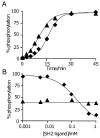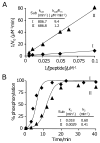An adaptor domain-mediated autocatalytic interfacial kinase reaction
- PMID: 19821459
- PMCID: PMC2856317
- DOI: 10.1002/chem.200901345
An adaptor domain-mediated autocatalytic interfacial kinase reaction
Abstract
This paper describes a model system for studying the autocatalytic phosphorylation of an immobilized substrate by a kinase enzyme. This work uses self-assembled monolayers (SAMs) of alkanethiolates on gold to present the peptide substrate on a planar surface. Treatment of the monolayer with Abl kinase results in phosphorylation of the substrate. The phosphorylated peptide then serves as a ligand for the SH2 adaptor domain of the kinase and thereby directs the kinase activity to nearby peptide substrates. This directed reaction is intramolecular and proceeds with a faster rate than does the initial, intermolecular reaction, making this an autocatalytic process. The kinetic non-linearity gives rise to properties that have no counterpart in the corresponding homogeneous phase reaction: in one example, the rate for phosphorylation of a mixture of two peptides is faster than the sum of the rates for phosphorylation of each peptide when presented alone. This work highlights the use of an adaptor domain in modulating the activity of a kinase enzyme for an immobilized substrate and offers a new approach for studying biochemical reactions in spatially inhomogeneous settings.
Figures






Similar articles
-
Rate enhancement of an interfacial biochemical reaction through localization of substrate and enzyme by an adaptor domain.J Phys Chem B. 2010 Nov 25;114(46):15113-8. doi: 10.1021/jp102820e. Epub 2010 Nov 3. J Phys Chem B. 2010. PMID: 21047083 Free PMC article.
-
Processive phosphorylation of p130Cas by Src depends on SH3-polyproline interactions.J Biol Chem. 2001 Jul 27;276(30):28190-6. doi: 10.1074/jbc.M100055200. Epub 2001 Jun 1. J Biol Chem. 2001. PMID: 11389136
-
Interactions between the Fyn SH3-domain and adaptor protein Cbp/PAG derived ligands, effects on kinase activity and affinity.FEBS J. 2008 Oct;275(19):4863-74. doi: 10.1111/j.1742-4658.2008.06626.x. Epub 2008 Aug 21. FEBS J. 2008. PMID: 18721137
-
Kinetics of Src homology 3 domain association with the proline-rich domain of dynamins: specificity, occlusion, and the effects of phosphorylation.J Biol Chem. 2005 Jun 17;280(24):23147-56. doi: 10.1074/jbc.M501745200. Epub 2005 Apr 17. J Biol Chem. 2005. PMID: 15834155
-
IRS-1 activates phosphatidylinositol 3'-kinase by associating with src homology 2 domains of p85.Proc Natl Acad Sci U S A. 1992 Nov 1;89(21):10350-4. doi: 10.1073/pnas.89.21.10350. Proc Natl Acad Sci U S A. 1992. PMID: 1332046 Free PMC article.
Cited by
-
Exploring the Ligand Preferences of the PHD1 Domain of Histone Demethylase KDM5A Reveals Tolerance for Modifications of the Q5 Residue of Histone 3.ACS Chem Biol. 2021 Jan 15;16(1):205-213. doi: 10.1021/acschembio.0c00891. Epub 2020 Dec 14. ACS Chem Biol. 2021. PMID: 33314922 Free PMC article.
-
Fluorescence lifetime imaging of biosensor peptide phosphorylation in single live cells.Angew Chem Int Ed Engl. 2013 Apr 2;52(14):3931-4. doi: 10.1002/anie.201209303. Epub 2013 Feb 28. Angew Chem Int Ed Engl. 2013. PMID: 23450802 Free PMC article. No abstract available.
-
Activation State-Dependent Substrate Gating in Ca2+/Calmodulin-Dependent Protein Kinase II.Neural Plast. 2017;2017:9601046. doi: 10.1155/2017/9601046. Epub 2017 Dec 17. Neural Plast. 2017. PMID: 29391954 Free PMC article.
-
Using Microfluidics and Imaging SAMDI-MS To Characterize Reaction Kinetics.ACS Cent Sci. 2019 Mar 27;5(3):486-493. doi: 10.1021/acscentsci.8b00867. Epub 2019 Feb 12. ACS Cent Sci. 2019. PMID: 30937376 Free PMC article.
-
Steady-state of an enzymatic reaction is dependent on the density of reactant.Langmuir. 2013 Jan 8;29(1):294-8. doi: 10.1021/la3034066. Epub 2012 Dec 13. Langmuir. 2013. PMID: 23130977 Free PMC article.
References
-
- Shen-Orr SS, Milo R, Mangan S, Alon U. Nat Genet. 2002;31:64–68. - PubMed
-
- Mayer BJ, Hirai H, Sakai R. Curr Biol. 1995;5:296–305. - PubMed
- Pellicena P, Stowell KR, Miller TW. J Biol Chem. 1998;273:15325–15328. - PubMed
- Lewis LA, Chung CD, Chen Jy, Parnes JR, Moran M, Patel VP, Miceli MC. J Immunol. 1997;159:2292–2300. - PubMed
- Duyster J, Baskaran R, Wang JYJ. Proc Natl Acad Sci U S A. 1995;92:1555–1559. - PMC - PubMed
Publication types
MeSH terms
Substances
Grants and funding
LinkOut - more resources
Full Text Sources
Other Literature Sources
Miscellaneous

